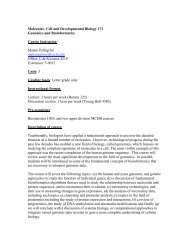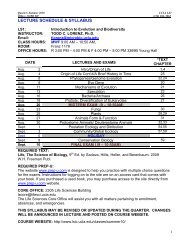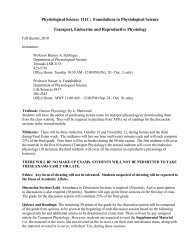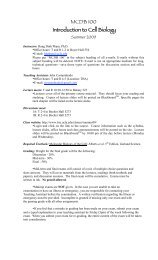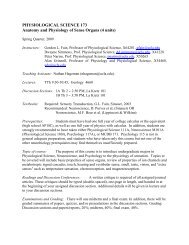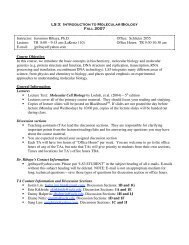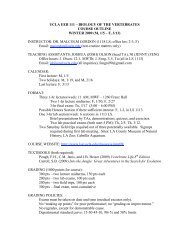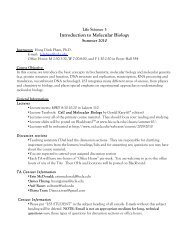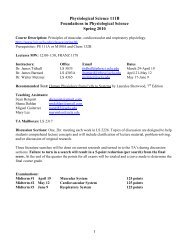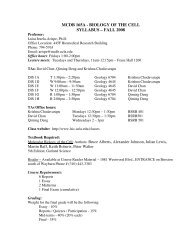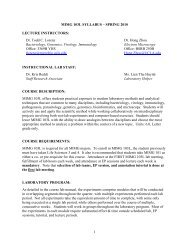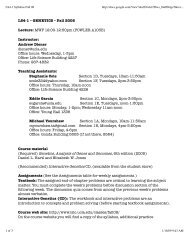Physiological Science 111L - UCLA
Physiological Science 111L - UCLA
Physiological Science 111L - UCLA
You also want an ePaper? Increase the reach of your titles
YUMPU automatically turns print PDFs into web optimized ePapers that Google loves.
<strong>Physiological</strong> <strong>Science</strong> <strong>111L</strong>Laboratory ManualWinter Quarter 2010
ContentsIntroductionPageCourse OutlineiGuidelines concerning use of animalsiiLaboratory safetyiiiParticipation in exercises to measure human physiological responses iiiPersonnel involved in <strong>111L</strong>ivInstructional Policy and Evaluation of PerformancevUse of the MacLab data acquisition and analysis systemviiiComputer Simulation of Action Potential 2.1Electromyography 3.1Human Electrocardiogram and Blood Pressure 4.1Compound Action Potential – Frog Sciatic Nerve 5.1Frog Skeletal Muscle Contraction 6.1Human Respiration 7.1Measurement of Active Sodium Transport in Frog Skin 8.1Computer Simulation of Water and Solute Movement in the Kidney 9.1Hormonal Control of Reproduction – Evaluation of Estrus Cycling in the Rat 10.1
2. Guidelines concerning use of animals:The Animal Care and Use training Manual published by the Chancellor’s AnimalResearch Committee provides guidelines on the care and use of laboratory animals at<strong>UCLA</strong> (a copy is available in the laboratory). As stated in the preface to the manual,<strong>UCLA</strong> recognizes that the use of animals for teaching and research is fundamental tobiology and medicine.In setting up the present course a great deal of effort has been taken to designexperiments which demonstrate important physiological principles and at the same timeminimizes the use of animals. All experiments involving the use of animals (frogs andrats) have been approved by the Chancellor’s Animal Research Committee.Since you will be working with live rats in week 10 you will be required to (i)observe a video dealing with procedures for correct handling of rats, and (ii) complete a<strong>UCLA</strong> Medical History Questionnaire (Health Questionnaire) ONLINE. These twoitems will be addressed in week 7..3. Laboratory SafetyPlease no eating or drinking in the laboratory. Take extreme care when using anysharp instrument during dissections. Disposable latex gloves are provided for your usewhen performing dissections. For human performance measurements, disposablesupplies will be used whenever feasible; spirometers will be sterilized before use.In performing wet lab experiments (weeks 5.6 and 8) take care to avoid contact ofsolutions with the computer equipment; keep all tissue preparation materials to the righthand area of the bench as far removed as possible from the computers.4. Participation in exercises to measure human physiological responses:Several of the laboratory sessions will involve making simple, non-invasivemeasurements of various physiological responses, e.g. blood pressure, EKG andrespiratory measurements, on other student volunteers and examining how theseresponses may be influenced by the state of physical activity of the person, eg. whenusing an exercise bicycle. If you have any medical condition that may be adverselyaffected by participating in these exercises, you should not volunteer to perform theseexercise routines.5. PS<strong>111L</strong> WebsiteAs with other undergraduate classes, there will be a website devoted to this class.The class schedule is listed there and it contains a bulletin board for your use. Youshould periodically check the site for any updated information about the course.Personnel involved in <strong>111L</strong>Instructor:Dr. Ronald H. CooperOffice: 1812 Life <strong>Science</strong> BuildingPhone: 206 – 3201Email: rcooper@physci.ucla.eduOH: Tues 10 – 11 amFri 9.30 – 10.30 am
TA’s:Bo Deng (Wed/Fri)e-mail: bodeng@ucla.eduOH Mon 2 – 4 pm (LS 5323)Grace Liu (Tues/Thur)e-mail glueliu@ucla.eduOH Mon 3-4 pm (LS 5826)Wed 3-4 pm (LS 5826)Faculty:Since the <strong>111L</strong> course is designed to complement the <strong>111L</strong> lecture series each ofthe laboratory modules was developed in collaboration with faculty involved in theteaching of the <strong>111L</strong> lecture courses. In addition to those faculty (listed below in theorder according to which their respective laboratory modules appear in this course), Dr.Scott Chandler, Dr. Gordon Fain, and Dr. Judith Smith who previously lectured in the111A, 111B, and 111C courses, contributed to the development of those laboratorymodules relevant to their teaching area is as follows:Dr. Peter Narins – Computer Simulation of Action PotentialDr. Peter Narins – Action Potential in frog nerveDr. David Glanzman – ElectromyographyDr. James Tidball – Frog skeletal muscle contractionDr. James Barnard – Human electrocardiogram and blood pressureDr. Nicholas Mellen – Human RespirationDr. Nasser Farahbakhsh – Active sodium transport in frog skinDr. Nasser Farahbakhsh – Computer simulation of water & solute movement in kidneyDr. Barney Schlinger – Hormonal control of reproduction
Instructional Policy and Evaluation of PerformancePhysiology is concerned with the study of the function of individual tissues andorgans and how they interact within the whole organism. Our understanding of theseinteractions and their contribution to homeostasis has developed from experimentalmeasurements of the properties of living tissues.The laboratory in <strong>Physiological</strong> <strong>Science</strong> (PS<strong>111L</strong>) has been designed toaccomplish the following objectives:•To directly observe phenomena discussed in lecture and describe in the textbook•To provide hands – on experience in collecting physiological data•TO learn to interpret experimental data and based on analysis of the data to drawmeaningful conclusionsIn keeping with these objectives, the following guidelines should help you inunderstanding what is expected of you in this laboratory course:1. Attendance at all laboratory sessions is required:Any unexcused absences will adversely affect your performance in the course,since there will be no provision for you to make up any missed sessions. If you miss alaboratory session in this manner you will not be permitted to turn in a laboratory reportor problem set using data from someone else, since development of practical, dataacquisition skills is one of the primary objectives of the course.2. Time and Location:Each weekly laboratory session is in room 5323 Life <strong>Science</strong>s Building, exceptfor the computer simulation sessions (weeks 2 and 9) which will be held in the <strong>Science</strong>Learning Center (Room TBA, Young Hall) after the introductory talk in LS 5323. Withthe exception of the computer simulation sessions, you will work as a member of a teamwith one or two other students; team assignments will be made during the first week ofthe course.3. Submissions of laboratory reports and problem sets:Following the completion of laboratory sessions in weeks 2 – 10, you will berequired to submit a laboratory report or answers to a problem set (which format will bespecified in the laboratory instructions) for grading (see below, #5). All assignments aredue at the beginning of the next laboratory session, (the TA will check in assignmentsduring class), unless stated otherwise by the course instructor or TA. Assignments whichare late will be penalized 2 points for each day it is late, up to a maximum of 20 points,after which that assignment may be turned in before the end of the quarter with nopenalty beyond the maximum.4. Preparation of Laboratory Reports and problem sets:Results from four of the laboratory sessions (weeks 3,5,6, and 8) will be presentedas Laboratory Reports, designed to provide you with experience in writing and analyzing
your experimental data in the style of a published journal article. Your laboratory reportshould be divided into the following sections:Summary – 100 word maximum, stating the purpose of the study, experimentalresults obtained and including key results (experimental values).Results – approx. 1 – 2 pages, this narrative section should describe the dataobtained; e.g. “Fig. 1 shows the time course of…“ Any interesting features concerningthe data in particular Figures or Tables should be pointed out; e.g. “….increases linearlywith time.”Discussion – approx. 1 – 2 pages, this section should interpret the data in thecontext of underlying mechanisms; e.g. if the sciatic nerve becomes refractory toelectrical stimulation in a particular figure, the underlying basis of this should be brieflyexplained. If data deviates from theory or expectation, possible explanations should beprovided in the discussion section.Presentation of data as Figures and Tables:During the course of each experiment you will obtain the necessary figures eitherdirectly, or as derived data e.g. calibration curves plotted using “Cricket Graph.” Beforewriting the “Results Section” organize your figures (and any Tables you generate) in themost appropriate sequence for logical presentation (this may be the order in which youcarried out the experiments or some other order which you deem more appropriate.)Each figure (and any tables which you develop) must have an accompanyinglegend (typed or handwritten legibly on the same sheet as the figure) in the form of:“Figure #: followed by a short descriptive title, and one or two sentences describing howthe data was obtained”. Please note that it is NOT necessary to duplicate data alreadypresented in a figure, in a table; tables should only be used to display data no shown infigures whose presentation is more appropriate in tabular form. All figures and tablesshould be placed together in the Lab Report, following the discussion section.To receive maximal credit, it is important that you follow the above guidelines, aseach Lab Report will be graded on the following basis: Summary (10 points), Results (15points), Discussion (15 points), Presentation of Tables and Figures – legends (10 points)for a total of 50 points. Remember that, as in any published article, clarity and accuracyof expression is important.For assignments other than Lab Reports, please follow the specific instructionsprovided.When writing up your laboratory report or problem set you are expected to do soentirely on your own; copying or paraphrasing another person’s work constitutesplagiarism and is a serious violation of the academic code of conduct. While you areencouraged to interact with other students in analyzing and understanding the data whichyou collect, when you write up your results you should use your own words and style ofpresentation.
5. Grading:Each of the 9 laboratory reports or problem sets (weeks 2 – 10) will be graded (50points each). Your overall grade for the course will be based on your accrual of pointsfrom each of the 9 laboratory reports or problem sets (50 points each); total points = 450.6. Deriving the maximum benefit from the course:Before coming to each laboratory session read the Laboratory manual tofamiliarize yourself with the experiment for that session. It is your responsibility to knowwhat measurements and calculations you are required to make during the course of theexperiment so that you can successfully complete the laboratory report or problem set.At the commencement of each laboratory session there will be a short overview (approx.20 min) of the laboratory given by a faculty or staff member, and to encourage dialogueyou may be asked questions.Along with arriving prepared for the class it is also important that you organizeyourself well to carry out the experiment. Since you will be working in teams of 4persons, assigned during week 1, decide among your team how you will accomplish theobjectives. Thus one person may accept primary responsibility for carrying out the nervedissection (week 4), while another person familiarizes themselves with theinstrumentation. Even if time does not permit each individual to do every task associatedwith that experiment, at least be aware of how and why something was done.It is also very important that you keep accurate records of what was done duringeach stage of the experiment. When you come to write up the experimental data you maynot be able to remember things you have a written record. Therefore, provide yourselfwith a laboratory notebook and bring it to class.A printer is networked to each of the five MacLab – based workstations in thelaboratory, so that you can obtain a hardcopy of your experimental results. Beforefinishing up each laboratory session make sure that you have copies of all the necessarydata that you will require to complete the particular assignment. You may wish to bringyour own 3.5” diskette to the laboratory to record your data files in this way, but you willhave to establish whether your own data handling capability is compatible with the PowerMacintosh system in use in the laboratory. We do not have the capability to allow you towrite up or print out your entire laboratory report using the laboratory computers orprinter.



